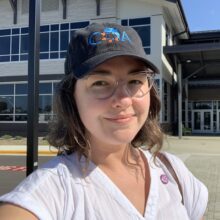More than 34,000 children in North Carolina have experienced the death of a parent since 2020


Katie here, bringing you this week’s updates in early care and education!
When I started working for EdNC in October 2021, I came in with a project. I’d just read a report that estimated the number of children who had experienced the death of a caregiver due to COVID-19, and I knew that schools would need to find ways to support them. I wanted to know how they were going to do that.
But when I started reaching out to schools, I learned that the vast majority of bereaved children weren’t grieving a COVID-19 death. Their caregivers had died of opioid, car crashes, gun violence, or other diseases.
A new report from Evermore, a national nonprofit organization advocating for support of bereaved children and families, backs this up.
Evermore’s researchers estimate that 34,581 children in North Carolina experienced the death of a parent since 2020. But deaths associated with COVID-19 only accounted for 2,575 of those children — less than 8%.
As policymakers consider strategies to support bereaved children, Joyal Mulheron, founder and executive director of Evermore, is worried they may focus solely on children whose parents were killed by COVID-19.
“By leaving homicide victims out of this, and leaving suicide and overdose out,” Mulheron told me, “we will be leaving so many incredibly vulnerable children behind.”
Below, check out early childhood updates from the General Assembly (or technically a lack thereof), a deep dive into licensed child care data in majority-Black counties, and new research about the availability of crucial amenities in the neighborhoods where Black children live.
Early Bird reads: What we’re writing
EdExplainer: Using the Child Care Statistical Report to learn about licensed child care in majority-Black counties
We used the Child Care Statistical Report released by N.C. Division of Child Development and Early Education each month to see how licensed child care in the state’s eight majority-Black counties differs from the other 92 counties. We learned that majority-Black counties have a higher proportion of home-based sites and a lower proportion accepting subsidies. We explored some possible reasons why.
More than 34,000 children in North Carolina have experienced the death of a parent since 2020
No one knows exactly how many children in North Carolina have experienced the death of a parent, but new estimates put the total number of “parentally bereaved” children in our state at more than 72,000. While almost half of those children had that experience since the beginning of the pandemic, less than 8% was due to COVID-19-associated deaths.
Your take, for goodness sake: EdNC perspectives
Perspective | New online tools provide snapshot of NC early childhood landscape
The NC Early Childhood Foundation has released a Pathways Data Dashboard and Action Map to help people see how early care and education is connected to third grade reading capabilities.
In other early learning news: What I’m reading
"What About People Like Me?" Teaching Preschoolers about Segregation and "Peace Heroes" - From NAEYC
Examining The Preschool to First-Grade Literacy and Language Outcomes of Black Children Experiencing a High-Quality Early Childhood Program - From The University of Chicago Press Journals
With federal child care legislation abandoned, it’s up to states to help working families - From Brookings
Subsidy reimbursement rates in Texas remain far below the true cost of providing child care - From Prenatal-to-3 Policy Impact Center
Pritzker calls for universal preschool in Illinois by 2027 - From Associated Press
Why More States Don't Have Universal Pre-K - From FiveThirtyEight
Research & Resources: Let's talk about Black children living in neighborhoods without essential amenities
As I was putting the finishing touches on Early Bird this week, I saw an email from the folks at Child Trends about their newest research. I had planned on writing about this study in which babies outperformed artificial intelligence (AI) in “commonsense psychology,” but I had to pivot. While AI might be a hot topic in education right now, social determinants of health are more relevant to all of our lived experiences.
Here’s what caught my attention. Using data from the 2020-2021 National Survey of Children’s Health (NSCH), Child Trends found that “most Black children in the United States live in neighborhoods that lack amenities associated with children’s healthy development and well-being —a legacy of residential segregation and other racial and environmental inequities.” These amenities are sidewalks, parks, recreational centers, and libraries.
While the researchers note that the lack of amenities varies by location and family income, they found Black children with the least access to neighborhood amenities live right here in the South.
According to the researchers, here’s how neighborhood amenities function as social determinant of health:
- Sidewalk access is associated with higher rates of physical activity and lower risks of childhood obesity. It also provides children with safer routes to schools.
- Parks and playgrounds are related to higher rates of health-enhancing behaviors and adolescents’ mental health.
- Recreational centers provide safe, supervised out-of-school-time programs for children and youth that are linked to positive developmental outcomes such as internal self-regulation.
- Public libraries provide books, videos, games, and a variety of literacy programs for children and families. They also serve as community hubs, connecting children and adults with needed resources, services, and information. Library use is also positively associated with students’ reading achievement.
I’m curious to know how the neighborhoods where Black children live compare to neighborhoods where children from other racial and ethnic backgrounds live, but for now, this research could be super useful to communities looking to improve the health and well-being of Black children — especially in the South.
You can read the full report and see related charts from Child Trends here. And if you want to learn more about the general importance of neighborhood amenities, I highly recommend the book “Palaces for the People” by Eric Klinenberg.


